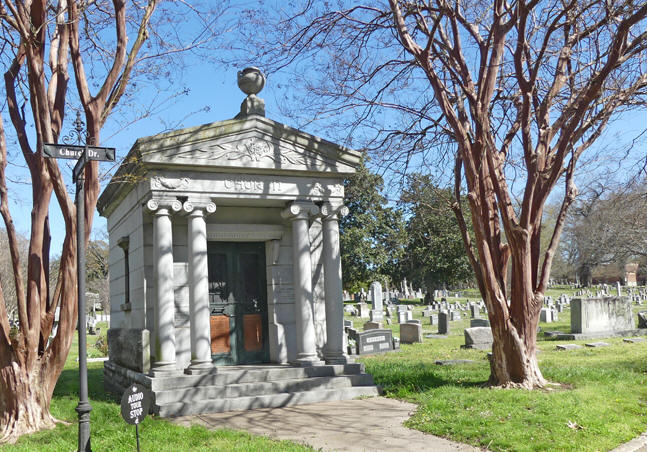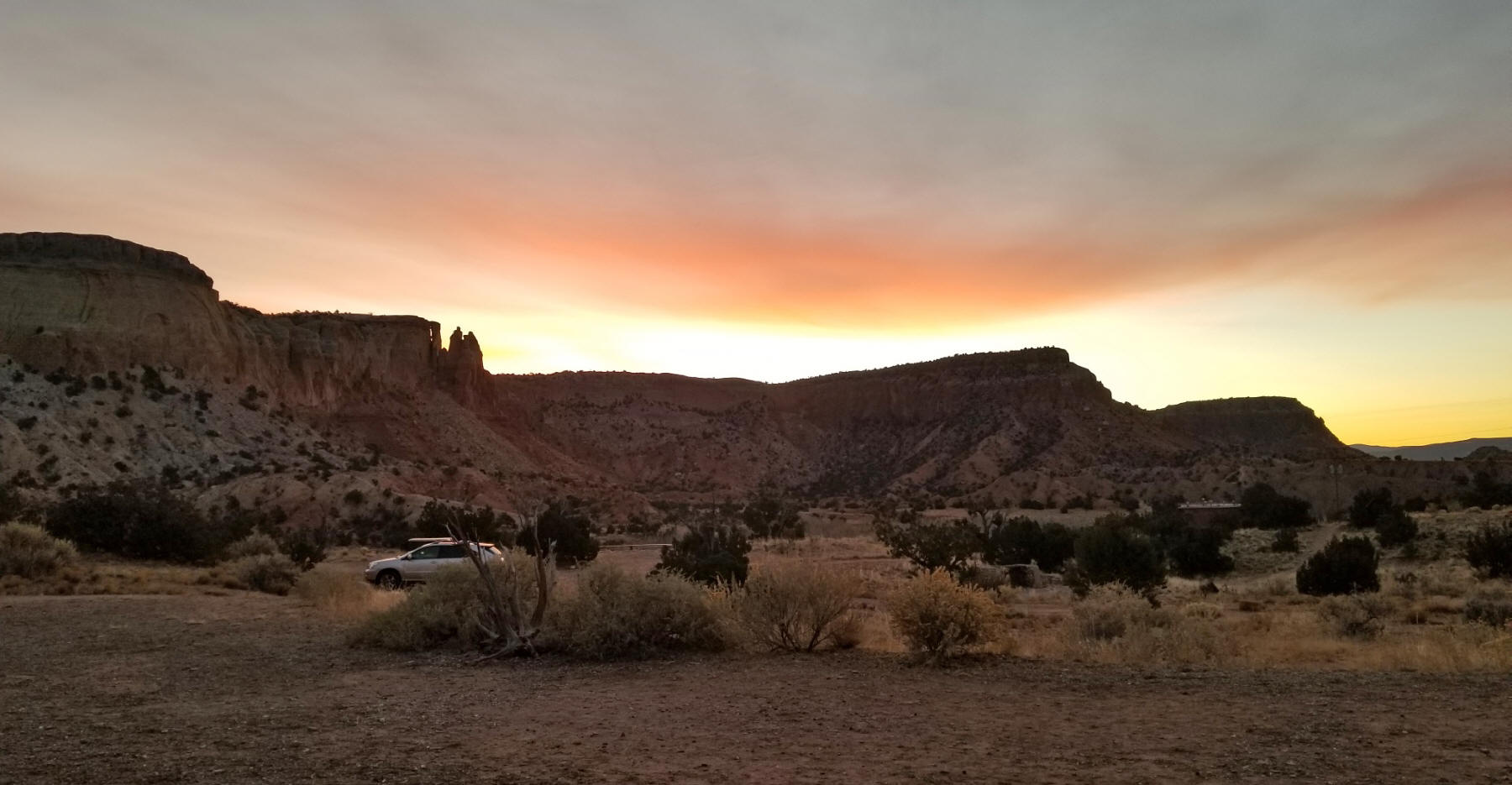Story and photos
by Kathleen Walls
.jpg)
Often a historic cemetery reflects that
city’s history. That is the case with beautiful Elmwood
Cemetery in Memphis. Elmwood was founded in 1852. Elmwood’s
executive director Kim Beaden and Amanda Zorn,
Historian/Visitor Services & Volunteer Coordinator, showed me
around the cemetery. It has the feel of a garden with beautiful
southern magnolia, poplar tulip, and giant water oak trees.
Elmwood is divided into sections including the Masonic Section,
the Confederate Rest section, the Yellow Fever Section, African
American Section, and others. Many of the tombstone sculptures
resemble a museum.
Earliest Residents
Although the first burial was Mrs. R. B.
Berry on July 15, 1853, Colonel John Smith is the only veteran
of the American Revolution buried at
Elmwood. Originally from
Virginia, he was buried there in 1851, was disinterred twice,
and buried in his present tomb in Elmwood two decades later.
There are 14 soldiers from the War of 1812, along with later
veterans from the Civil War, World Wars, Korea, and Vietnam.
John Overton Grave
.JPG)
John Overton III’s grave, dated 1943,
connects to the city’s founding. His grandfather, John Overton,
along with James Winchester, and Andrew Jackson founded
Memphis. The latter Overton was a banker, business executive,
member of the state house and senate, and one of the wealthiest
men in the state of Tennessee. His elaborate tombstone
showcases his wealth.
Confederate Rest
During
the Civil War, Tennessee was a very divided state. In 1860,
Memphis had Tennessee’s largest cotton and slave markets and
was a major Mississippi River port. At a naval battle in June
1862, Union vessels defeat eight Confederate ships and occupied
the city for the rest of the war.
Some of the prominent Confederate generals
buried at Elmwood are George Gordon, Alfred Jefferson Vaughan,
Jr., and Gideon Pillow.
Kit Dalton, who was a former Confederate
guerrilla fighter who rode with Quantrill’s Raiders and after
the war, was a member of Frank and Jesse James’s gang. Dalton
at one time had a $50,000 bounty for his capture, dead or
alive. He lived his later years until 1920 peacefully in
Memphis and has a small monument marking his burial spot at
Elmwood.
Many Union soldiers were originally buried
across from the Confederate dead, but most were moved to the
Memphis National Cemetery in 1868. Reportedly, two remain at
Elmwood. One, William Jay Smith, was a Union General who later
became prominent as a member of both state house and senate and
later a member of the United States House of Representatives.
African American Section

From the beginning, Elmwood was a burial
ground for all races. There are African Americans buried here -
both free and slave. As was the practice in the times, Elmwood
was segregated.
When the Civil War began, there were about
3,000 enslaved people in Memphis. They were the main workers in
the cotton industry and trade along the Mississippi River. A
monument recognizes the more than 300 unnamed enslaved people
buried in Elmwood from its beginning to the end of the Civli
War.
One Black man proved his race could
succeed even when the odds were against them. Robert Church was
the first Black millionaire in Memphis and the entire South. He
was born into slavery in 1839 and escaped during the Civil War.
He worked at whatever jobs he could get in Memphis and saved up
enough money to buy a saloon on Beale Street. During what was
known as “the 1866 Memphis Massacre,” he was shot in his saloon
and left for dead. Against the odds, he survived and became
wealthy in real estate and banking. His bank, unlike most
others, loaned money to Black citizens to buy a home.
He owned a 2,200-seat auditorium named
Church Park, the only Black-owned auditorium in the country.
His auditorium hosted dignitaries ranging from Theodore
Roosevelt to Booker T. Washington. W. C. Handy, “The Father of
the Blues” was his band leader.
Chinese Section
.JPG)
There are 266 graves, marked and unmarked,
of Chinese Americans here. In the early 1970s, during
reconstruction, Chinese people came to the Memphis and the
Mississippi Delta area to build the levees and the railroads.
Many had migrated from the west, where they had worked on the
transcontinental railroad.
No Man’s Land

The Yellow Fever section, also called No
Man’s Land, is named because it does not have a true section
name. It is populated by about 1500 burials of people who died
in the yellow fever epidemics of 1873,1878, and 1879. During
these outbreaks, Elmwood was doing over fifty burials a day.
With the epidemic raging and labor shortages, many bodies were
just piled together on the ground for days awaiting burial.
Trenches in an area formerly reserved for paupers and unknowns
now housed people of all economic status and religions.
Memphis Madam
.jpg)
Like all cities, there was a bit of
lawlessness in Memphis, but sometimes lawbreakers are not all
bad. Emily Sutton, who operated under the name of Fannie
Walker, was a Memphis madam. Before arriving in Memphis, it
appears that Fannie was operating a “house of ill-fame” in
Nashville, where she was fined $3 plus court costs in August
1869.
She apparently moved her business to
Memphis. The Memphis Daily Appeal reported on Feb 22,
1870, that Fannie Walker was arrested for “keeping a house of
ill-fame” and was fined a dollar. She was back before the
Memphis court in April 1871 along with many other women of
“ill-repute,” once again for operating a house of ill repute.
When the fever epidemic struck in 1873, she transformed her
“house of ill repute” into a field hospital. She caught Yellow
Fever and died during the epidemic. Her tombstone shows that
she left behind a good bit of money when she died.
Civil War History
.jpg)
Shelby Foote, a novelist but also known
for his authorship of The Civil War: A Narrative, a
three-volume history of the American Civil War. He appeared in
Ken Burns’s PBS documentary The Civil War in 1990.
Memphis Music History
.jpg)
A stone with a man that looks like he’s
playing a trumpet brings to mind Memphis’s long
musical
history. That’s a memorial to Wayne Jack, a soul and R&B
musician. His tombstone recalls him playing the trumpet in The
Mar-Keys, the house band at Stax Records and later as one of
The Memphis Horns, which had been described as “the greatest
soul horn section ever."
Civil Rights
The City of Memphis will always be
remembered as home one of the blackest days in the Civil Rights
Movement when Dr. Martin Luthor King, Jr. was assassinated at
the Lorraine Motel, now the
National Civil Rights Museum. It
will bring a tear to any feeling human who visits. Elmwood is
the final resting place of two civil rights workers. Benjamin
Hooks, who throughout a lifetime of fighting for equality,
joined Dr. King’s Southern Christian Leadership Conference and
was a pioneer in restaurant sit-ins and other boycotts, the
first African American on the Federal Communications Commission
(FCC), and executive director of the NAACP. In 1990, he and his
family were targeted in a wave of bombings against civil rights
leaders. Before his death in 2010, he was awarded the
Presidential Medal of Freedom, the nation’s highest civil award
on November 5, 2007.
Another notable Civil Rights worker buried
at Elmwood is Maxine Smith, know as the Mother of the Civil
Rights Movement in Memphis. She served on the National Board of
the NAACP and was the Executive Secretary of the Memphis Branch
of the NAACP, where she worked for the desegregation of
everything in Memphis.
Other Monuments and Structures
Another notable monument at Elmwood
Cemetery is one dedicated to the 19 children buried here who
perished at the hands of a black-market adoption ring called
The Tennessee Children’s Home Society.
“In memory of the 19 children who finally
rest here unmarked if not unknown, and of all the hundreds who
died under the cold, hard hand of the Tennessee Children’s Home
Society. Their final resting place unknown. Their final peace a
blessing. The hard lesson of their fate changed adoption
procedure and law nationwide.”
.JPG)
The Phillips Cottage, which serves as the
Visitor Center and office, is the only known example of
Victorian Carpenter Gothic architecture in Memphis. It was
built in 1866 and is on the National Register of Historic
Places.
The Lord’s Chapel offers a place for
services and the many private family mausoleums and tombs will
give insight into what makes Memphis the city it is today.
Public Disclosure
Please Read
FTC has a law
requiring web sites to let their readers know if any of the
stories are "sponsored" or compensated. We also are to
let readers know if any of our links are ads. Most are not.
They are just a way to direct you to more information
about the article where the link is placed. We have several ads
on our pages. They are clearly marked as ads. I think
readers are smart enough to know an ad when they see one but to
obey the letter of the law, I am putting this statement here to
make sure everyone understands. American Roads and Global
Highways may contain affiliate links or ads. Further, as their
bios show, most of the feature writers are professional travel
writers. As such we are frequently invited on press trips, also
called fam trips. On these trips most of our lodging, dining,
admissions fees and often plane fare are covered by the city or
firm hosting the trip. It is an opportunity to visit places we
might not otherwise be able to visit. However, no one tells us
what to write about those places. All opinions are 100% those
of the author of that feature column.



